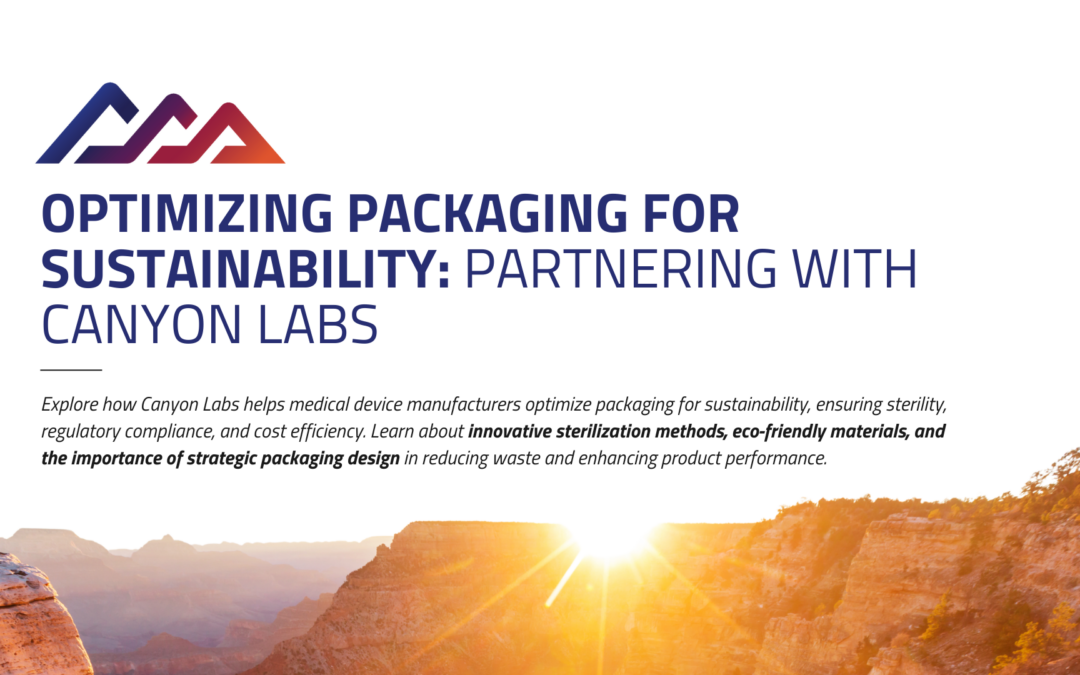In the sterile medical device industry, maintaining product sterility is non-negotiable—but achieving it sustainably is becoming just as important. As manufacturers face growing pressure to reduce environmental impact, they must carefully balance packaging design, sterilization methods, and regulatory compliance. Successfully navigating these challenges requires a strategic approach—one that supports innovation and efficiency without compromising safety or performance.
Comprehensive Packaging Considerations
A holistic approach to packaging ensures that medical devices remain sterile, functional, and compliant. Key areas to focus on include:
Concept & Design: Packaging should be tailored to meet regulatory and sterilization requirements while optimizing material use.
Material Selection & Engineering: Choosing sustainable, high-performance materials suited to specific sterilization modalities and device needs is essential.
Prototype Development & Testing: Validating packaging designs for durability, permeability, and compatibility with sterilization processes ensures safety and compliance.
Regulatory & Compliance Support: Adhering to FDA, ISO, and other industry standards reduces the risk of delays or failures.
Ongoing Optimization & Sustainability: Continuously refining packaging solutions can help reduce waste, improve efficiency, and enhance overall product performance.
Optimizing Packaging for Sustainability
Reducing environmental impact while maintaining sterility can be achieved through strategic packaging choices:
Recycled Materials: Using recycled content can decrease waste and improve sustainability metrics.
Efficient Design: Reducing sterilization load size and improving permeability can enhance process efficiency and minimize material usage.
Sterilization Compatibility: Packaging should allow proper air, gas, and / or water vapor penetration and removal to ensure effective sterilization. To optimize your packaging design for sterilization, you not only need to ensure the design has the proper penetration factor, but also consider a design that is able to go to more sustainable sterilization modalities.
Designing with Sterilization in Mind
The choice of sterilization modality directly affects packaging design. Important considerations include:
Material Selection: Different sterilization methods can impact materials in various ways, causing brittleness, color changes, stiffness, or odor issues.
Durability Requirements: Packaging must withstand extreme temperature and pressure during sterilization cycles.
Surface Area & Permeability: Ensuring adequate permeable surface area facilitates efficient sterilization and helps prevent process failures.
Reducing Packaging Waste and Enhancing ROI
Optimizing packaging not only supports sustainability but also improves cost efficiency.
Strategies include:
- Downsizing packaging and eliminating unnecessary materials
- Switching to eco-friendly marketing materials and digital instructions for use (eIFUs)
- Choosing materials with shorter lead times to mitigate supply chain risks
- Selecting materials that offer flexibility across multiple sterilization methods
Navigating Sterilization Modalities
Ethylene Oxide (ETO) has been the gold standard for sterilization, but rising regulatory scrutiny and environmental concerns are driving the industry to explore alternatives. The challenges with traditional ETO sterilization include:
Supply Chain Constraints: ETO availability is diminishing in the U.S., causing cost and lead time concerns.
Environmental & Health Risks: ETO emissions and toxicity have led to stricter regulations and industry pressure to reduce reliance on this method.
Legal & Compliance Considerations: Companies must prepare for evolving regulatory landscapes and potential restrictions on ETO use.
While ETO presents certain challenges, it remains the most widely used, accessible, and compatible sterilization method currently available. Before exploring alternative modalities, it’s essential to consider the broader sustainability implications of making a switch. For instance, if ETO sterilization is already integrated into your manufacturing facility, transitioning to another method could require extensive transportation to and from an off-site sterilization facility. The resulting environmental impact—through increased emissions from planes, trains, and automobiles—can significantly offset the intended sustainability gains. When evaluating sterilization options, it’s crucial to assess the entire supply chain and consider all factors that contribute to a truly sustainable solution.
Exploring Alternative Sterilization Methods
As the industry moves toward sustainability, new sterilization technologies are emerging. Some key alternatives include:
Gamma Radiation: Effective but reliant on limited Cobalt-60 supply.
Electron Beam (E-Beam): Fast and efficient but limited in penetration depth.
Hydrogen Peroxide: Ideal for low-temperature sterilization but not suitable for all devices.
Steam Sterilization: Works well for heat-resistant materials but unsuitable for moisture-sensitive devices.
Emerging Modalities: Techniques like vaporized peracetic acid and nitrogen dioxide are gaining interest but require FDA validation and scalability assessments.
When to Engage a Packaging Partner
Bringing a medical device to market requires strategic planning at every stage, and packaging plays a crucial role in ensuring product safety and compliance. Engaging a packaging partner like Canyon Labs can offer benefits in bringing your product to market with limited roadblocks:
Proactive Risk Mitigation: Identifying potential packaging challenges before they impact production timelines.
Regulatory Alignment: Ensuring packaging materials and designs comply with evolving industry standards.
Efficiency & Cost Savings: Reducing the need for redesigns by integrating packaging considerations from the outset, limiting retesting fees and additional test requirements.
By working with Canyon Labs, companies can navigate complex regulations, enhance sustainability, and accelerate their path to market through our technical consulting services. Visit our website to learn more about our nationwide packaging consulting and testing services.
The Road Ahead
As the medical device industry continues its shift toward sustainability, packaging optimization will play an increasingly critical role in balancing environmental responsibility with regulatory compliance and product safety. The path forward requires innovation, cross-functional collaboration, and a deep understanding of how packaging, sterilization modalities, and supply chain logistics intersect. By proactively addressing these challenges and engaging the right partners early in the process, companies can not only reduce their environmental footprint but also streamline development and improve time-to-market. At Canyon Labs, we’re committed to guiding organizations through this evolving landscape—helping them design smarter, safer, and more sustainable packaging solutions for the future.

